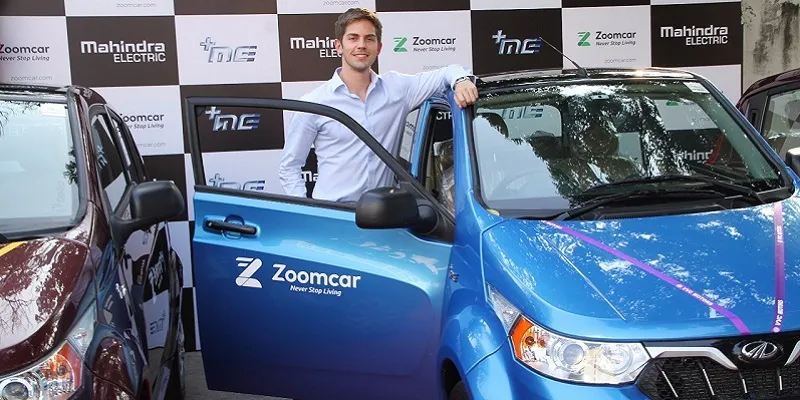Zoomcar’s Greg Moran, on what is driving ZAP Subscribe, and how the path to profitability is not always linear
In an interview with YourStory, Greg Moran the CEO and co-founder of the car rental platform, Zoomcar explains the thought process behind the startup’s latest offering.
Zoomcar has been in operations for five years. The Bengaluru-based car rental platform has a fleet of nearly 3,000 cars spread across 26 cities, and the firm has raised over $45 million in funding. In the end of January, the company stated that it turned EBITDA (Earnings before interest tax and depreciation) positive.
Earlier last year, Zoomcar had launched Zoomcar Associated Program (ZAP), which allows a customer to borrow a car directly from her neighbour. To do this, Zoomcar brought into its inventory cars that it had not bought.
Zoomcar can rent out an owner’s car when not in use. Once a vehicle is acquired, it joins the Zoomcar fleet, and the company pays the owner when it is used. A 25 percent commission on revenue is charged from associates.
By the end of last year, the company had a fleet of 2,600-3000 vehicles, which is a mix of company-owned and third claims. Its customer base is more than two million. Recently, it launched Cadabra, a full-stack solution to transform its fleet into Internet of Things (IoT) -enabled vehicles.
Equipped with Bluetooth and 4G cellular connectivity, Cadabra tracks several items of real-time in-car data and driver behaviour, including fuel levels, braking pattern, inconsistent acceleration, seatbelt usage and engine health. Any anomaly in driver behaviour emits a harsh sound, leading to alertness and, consequently, reduction in accidents.

Now the team has launched ZAP Subscribe. YourStory caught up with Zoomcar’s co-founder and CEO Greg Moran to find out more.
YourStory: How does the initial model of ZAP work, and why the shift to ZAP?
Greg Moran: Supply has always been a big constraint for Zoomcar. When we talk about Subscription, it is under the ZAP umbrella. ZAP has been our path towards growing supply, especially as we look to unlock more and more cities. ZAP is a flagship marketplace where individuals can put up their cars on the platform. They use and own the cars, and while they aren't using the cars, they can put it up for rent. The people who are on ZAP are spread all across the city, making it hyperlocal, giving a larger group of people access to a car. Earlier, a car owner would register a car under a three-way dealership between owner, financier and Zoomcar. You will be technically be the owner of the car, but when you are not using it you list it out on the platform.
YS: Why look at ZAP Subscribe?
Greg Moran: While ZAP got us traction, what we realised was that we weren't pushing it to the full potential. We realised there was a long lead time from the time when you say you want to be a ZAP associate till the time you get the car at your place. The core reason for this is it is a very different registration process for a black board car and a white board car. Financing documentation, regulatory regime take time - it is all legal but is an onerous process. While the Prime Minister’s Digital India initiative is, is making the relevant the transportation sector still has a long way to go.
So we wanted Zoomcar to act as a facilitator, where we manage the financing and all the paperwork. While the car papers are technically in our names, the vehicles are owned by the individuals.
The cars are immediately given out to individuals. From an operating standpoint everything is the same for an individual associate. We are giving you the car on a subscription; you are subscribing through Zoomcar. You are not going to a lender.
The process is clean. You enter the website and say you want XYZ car and the subscription includes the cost of the car, its insurance, registration and tax and IoT device (Cadebra) and it also includes maintenance.
YS: How much does the subscription cost?
Greg Moran: The beauty is that you don't have to pay Rs 2 to 3 lakh in equity down payment and insurance. You have to pay a refundable deposit of Rs 20,000 to Rs 40,000. You then pay a monthly subscription, which works like an EMI, somewhere between Rs 25,000 and 30,000 per month. It is like a subsided lease. There is nothing really novel about a subscription programme, but when you leverage subscribing and fraction of sharing we can subsidise the subscription by 70 percent.
We are looking at a subscription base of over 5,000 subscribers in the first half of 2018. Right now, we have taken expressions of interest, which are over 10,000.
YS: What levers have you had to change internally?
Greg Moran: We have always been supply-constrained as a business. Our pricing increased year-on-year multiple times. That is because we have high demand, and a supply constraint. As a result of this, the cost structure isn't fixed. The economics, therefore, get better when you are able to maintain the level of efficiency between demand and supply.
YS: Are you cashflow positive, and what is your path to profitability?
Greg Moran: Currently, we are cash flow positive. For any startup in this phase you are going to have people as your cost centre. But we look at that as an investment, because they are your best investment We keep a lean profile of over 200 people, which will more or less remain the same even as we scale. There are other cost centres of building a customer experience and imparting training, and we need to take a holistic approach. We don’t have cost centres with the marketplace with ZAP, as it is an enabling platform. You want to spend more of your money in terms of technology investment as well as market development. As we grow more and scale Subscribe, you will see how we will focus more on the demand side of the market differently.
YS: Will Subscribe be efficient, and what is your path to profitability?
Greg Moran: Subscribe is very efficient and we are able to look at it from a standpoint that we make more money for every booking that we take on Subscribe. It is about how you generate more bookings. We don't have costs associated from a unit perspective. When you build a financial model, people end up looking at it in a linear way.
It is not linear, it is about how you look at your end state; where you want to be in the next five years. We might be profitable today. but is it always in our best interests to be profitable in the future? It might not be.
It is unlikely that we will compete against an Ola or an Uber. You have two types of mobility platforms - one is driver-based and there is self-drive mobility, and the consumer will need both.
The kind of skill set needed to deliver fulfilment for both, are very different. In sometime we might have to be looking at technology a little differently, and in three months it might not be in our best interests to be profitable
We may plan quarterly or annually, but in the mobility business too much forward planning can actually be dangerous. Our end goal is to dominate self-drive mobility, across cars and cycles. And this is not just for India, it is even for emerging economies to handle day-to-day mobility requirement.







